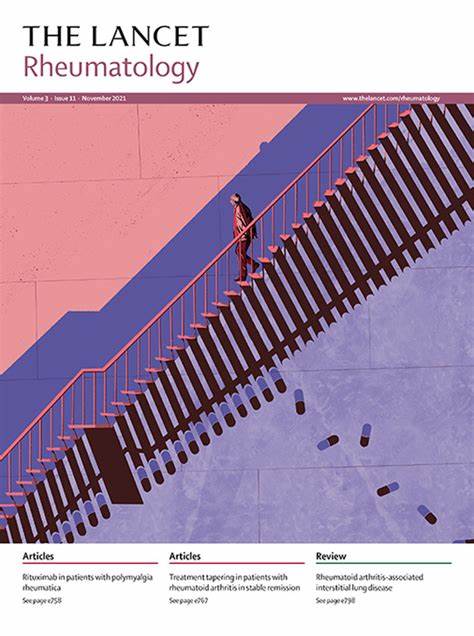Data-driven subclassification of ANCA-associated vasculitis: model-based clustering of a federated international cohort
IF 15
1区 医学
Q1 RHEUMATOLOGY
引用次数: 0
Abstract
Background
Antineutrophil cytoplasmic antibody (ANCA)-associated vasculitis is a heterogenous autoimmune disease. While traditionally stratified into two conditions, granulomatosis with polyangiitis (GPA) and microscopic polyangiitis (MPA), the subclassification of ANCA-associated vasculitis is subject to continued debate. Here we aim to identify phenotypically distinct subgroups and develop a data-driven subclassification of ANCA-associated vasculitis, using a large real-world dataset.
Methods
In the collaborative data reuse project FAIRVASC (Findable, Accessible, Interoperable, Reusable, Vasculitis), registry records of patients with ANCA-associated vasculitis were retrieved from six European vasculitis registries: the Czech Registry of ANCA-associated vasculitis (Czech Republic), the French Vasculitis Study Group Registry (FVSG; France), the Joint Vasculitis Registry in German-speaking Countries (GeVas; Germany), the Polish Vasculitis Registry (POLVAS; Poland), the Irish Rare Kidney Disease Registry (RKD; Ireland), and the Skåne Vasculitis Cohort (Sweden). We performed model-based clustering of 17 mixed-type clinical variables using a parsimonious mixture of two latent Gaussian variable models. Clinical validation of the optimal cluster solution was made through summary statistics of the clusters' demography, phenotypic and serological characteristics, and outcome. The predictive value of models featuring the cluster affiliations were compared with classifications based on clinical diagnosis and ANCA specificity. People with lived experience were involved throughout the FAIRVASVC project.
Findings
A total of 3868 patients diagnosed with ANCA-associated vasculitis between Nov 1, 1966, and March 1, 2023, were included in the study across the six registries (Czech Registry n=371, FVSG n=1780, GeVas n=135, POLVAS n=792, RKD n=439, and Skåne Vasculitis Cohort n=351). There were 2434 (62·9%) patients with GPA and 1434 (37·1%) with MPA. Mean age at diagnosis was 57·2 years (SD 16·4); 2006 (51·9%) of 3867 patients were men and 1861 (48·1%) were women. We identified five clusters, with distinct phenotype, biochemical presentation, and disease outcome. Three clusters were characterised by kidney involvement: one severe kidney cluster (555 [14·3%] of 3868 patients) with high C-reactive protein (CRP) and serum creatinine concentrations, and variable ANCA specificity (SK cluster); one myeloperoxidase (MPO)-ANCA-positive kidney involvement cluster (782 [20·2%]) with limited extrarenal disease (MPO-K cluster); and one proteinase 3 (PR3)-ANCA-positive kidney involvement cluster (683 [17·7%]) with widespread extrarenal disease (PR3-K cluster). Two clusters were characterised by relative absence of kidney involvement: one was a predominantly PR3-ANCA-positive cluster (1202 [31·1%]) with inflammatory multisystem disease (IMS cluster), and one was a cluster (646 [16·7%]) with predominantly ear–nose–throat involvement and low CRP, with mainly younger patients (YR cluster). Compared with models fitted with clinical diagnosis or ANCA status, cluster-assigned models demonstrated improved predictive power with respect to both patient and kidney survival.
Interpretation
Our study reinforces the view that ANCA-associated vasculitis is not merely a binary construct. Data-driven subclassification of ANCA-associated vasculitis exhibits higher predictive value than current approaches for key outcomes.
Funding
European Union's Horizon 2020 research and innovation programme under the European Joint Programme on Rare Diseases.
数据驱动的 ANCA 相关性血管炎亚分类:基于模型的国际联合队列聚类。
背景:抗中性粒细胞胞浆抗体(ANCA)相关性血管炎是一种异质性自身免疫性疾病。传统上,ANCA相关性血管炎被分为两种情况,即肉芽肿伴多血管炎(GPA)和显微镜下多血管炎(MPA),但ANCA相关性血管炎的亚分类仍存在争议。在此,我们旨在利用一个大型真实世界数据集,确定表型上截然不同的亚组,并建立一个数据驱动的ANCA相关性血管炎亚分类:方法:在数据重用合作项目 FAIRVASC(可查找、可访问、可互操作、可重用的血管炎)中,从六个欧洲血管炎登记处检索了 ANCA 相关血管炎患者的登记记录:捷克 ANCA 相关性脉管炎登记处(捷克共和国)、法国脉管炎研究小组登记处(FVSG;法国)、德语国家联合脉管炎登记处(GeVas;德国)、波兰脉管炎登记处(POLVAS;波兰)、爱尔兰罕见肾病登记处(RKD;爱尔兰)和斯科纳脉管炎队列(瑞典)。我们使用两个潜在高斯变量模型的拟合混合物对 17 个混合型临床变量进行了基于模型的聚类。通过对聚类的人口统计学、表型和血清学特征以及结果进行汇总统计,对最佳聚类方案进行了临床验证。将以聚类隶属关系为特征的模型的预测价值与基于临床诊断和ANCA特异性的分类进行了比较。有生活经验的人参与了整个FAIRVASVC项目:共有3868名在1966年11月1日至2023年3月1日期间被诊断为ANCA相关性血管炎的患者被纳入研究,这些患者来自六个登记处(捷克登记处n=371、FVSG n=1780、GeVas n=135、POLVAS n=792、RKD n=439和斯科纳血管炎队列n=351)。GPA患者有2434人(62-9%),MPA患者有1434人(37-1%)。确诊时的平均年龄为 57-2 岁(SD 16-4);在 3867 名患者中,2006 名(51-9%)为男性,1861 名(48-1%)为女性。我们发现了五个群组,它们具有不同的表型、生化表现和疾病结局。其中三个群的特征是肾脏受累:一个严重肾病群(3868 名患者中的 555 人[14-3%]),C 反应蛋白(CRP)和血清肌酐浓度较高,ANCA 特异性不一(SK 群);一个髓过氧化物酶(MPO)-ANCA 阳性的肾脏受累群(782 [20-2%]),伴有局限性肾外疾病(MPO-K 群);以及一个蛋白酶 3(PR3)-ANCA 阳性的肾脏受累群(683 [17-7%]),伴有广泛的肾外疾病(PR3-K 群)。有两个群组相对没有肾脏受累:一个是主要为 PR3-ANCA 阳性的群组(1202 [31-1%]),伴有炎症性多系统疾病(IMS 群组);另一个是主要为耳鼻喉受累和低 CRP 的群组(646 [16-7%]),主要为年轻患者(YR 群组)。与根据临床诊断或ANCA状态拟合的模型相比,集群分配模型对患者和肾脏存活率的预测能力更强:我们的研究强化了这样一种观点,即ANCA相关性血管炎并不仅仅是一种二元结构。数据驱动的ANCA相关性血管炎亚分类对关键结果的预测价值高于目前的方法:资金来源:欧洲罕见病联合计划下的欧盟地平线 2020 研究与创新计划。
本文章由计算机程序翻译,如有差异,请以英文原文为准。
求助全文
约1分钟内获得全文
求助全文
来源期刊

Lancet Rheumatology
RHEUMATOLOGY-
CiteScore
34.70
自引率
3.10%
发文量
279
期刊介绍:
The Lancet Rheumatology, an independent journal, is dedicated to publishing content relevant to rheumatology specialists worldwide. It focuses on studies that advance clinical practice, challenge existing norms, and advocate for changes in health policy. The journal covers clinical research, particularly clinical trials, expert reviews, and thought-provoking commentary on the diagnosis, classification, management, and prevention of rheumatic diseases, including arthritis, musculoskeletal disorders, connective tissue diseases, and immune system disorders. Additionally, it publishes high-quality translational studies supported by robust clinical data, prioritizing those that identify potential new therapeutic targets, advance precision medicine efforts, or directly contribute to future clinical trials.
With its strong clinical orientation, The Lancet Rheumatology serves as an independent voice for the rheumatology community, advocating strongly for the enhancement of patients' lives affected by rheumatic diseases worldwide.
 求助内容:
求助内容: 应助结果提醒方式:
应助结果提醒方式:


